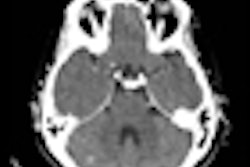ORLANDO - Coronary CT angiography (CCTA) is better than conventional risk scores and calcium scoring at predicting the long-term prognosis of patients with obstructive coronary artery disease, researchers reported at the annual meeting of the American College of Cardiology (ACC).
"CCTA is an emerging modality for assessing coronary artery disease and has good correlation with invasive angiography," said Dr. Martin Hadamitzky from the department of cardiology at Deutsches Herzzentrum München in Munich, Germany.
"We wanted to ask the question: How does it compare with more conventional methods [at predicting prognosis]?" he said.
The prospective observational study included 1,916 patients with suspected coronary artery disease undergoing both CCTA and calcium scoring at their institution between December 2003 and October 2007.
The maximum percentage stenosis of all coronary segments greater than 1.5 mm in diameter was assessed and then divided into four groups: less than 25%, 25% to 49%, 50% to 74%, and 75% or greater stenosis.
The end point was the occurrence of late cardiac events, which the researchers defined as cardiac deaths, nonfatal myocardial infarctions, angina requiring hospitalization, and coronary revascularization, 90 days or longer after CCTA.
During a median follow-up of 19 months, there were 199 early and 36 late events. In a receiver operator characteristics (ROC) analysis, the area under the curve of 0.88 for late events was significantly higher than the curve of calcium scores (0.75), the Morise clinical score (0.74), and the Framingham risk score (0.70).
"The difference between [coronary] CTA and the three other groups was highly significant," Hadamitzky said.
Also at the meeting, U.S. researchers reported that coronary CTA has high diagnostic accuracy for nonobstructive coronary artery disease. Researchers from Cornell University Medical Center in New York City hypothesized that the presence of nonobstructive plaque, as detected by 64-slice CCTA, can predict all-cause mortality.
That study involved 5,018 patients who underwent 64-slice CTA (LightSpeed VCT, GE Healthcare, Chalfont St. Giles, U.K.). Patients were excluded if they had obstructive coronary artery disease or prior revascularization. Of the total, 49.4% had nonobstructive coronary artery disease while the remainder had no plaque visualized by CCTA.
There was a statistically significant difference in all-cause mortality between patients with no plaque and nonobstructive plaque by CCTA, reported Dr. Fay Lin, a fellow in the division of cardiology at Cornell.
"Patients with no evident coronary artery plaque have an excellent intermediate-term prognosis," she said.
In contrast, multivariate Cox proportional hazards regression showed that nonobstructive plaque was independently predictive of a 3.39-fold increased risk of all-cause mortality.
"In patients with no diabetes, dyslipidemia, or hypertension, nonobstructive plaque was still associated with an elevated mortality risk of about 2% [over a two-year follow-up period]. This translates to a 10-year mortality rate of 10%," she said.
"CCTA may be useful to risk-reclassify patients not only with obstructive, but also with nonobstructive disease for the purpose of aggressive risk factor modification. Patients with nonobstructive disease may also be targeted for medical therapy," Lin said.
By Charlene Laino
AuntMinnie.com contributing writer
April 2, 2009
Related Reading
ACC study: Sequential CT delivers less radiation, good image quality, March 31, 2009
SCCT to publish coronary CTA guidelines, March 11, 2009
Diabetes renders coronary CTA more difficult, less successful, March 8, 2009
320-slice coronary CTA permits much lower contrast dose, March 6, 2009
Prospective coronary CTA performs well in heavy patients, February 27, 2009
Copyright © 2009 AuntMinnie.com



















